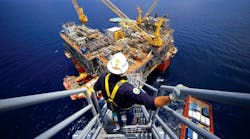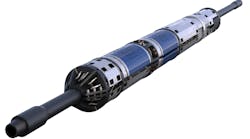Surface BOP, balanced drilling attractions
William FurlowPART IV: This is the fourth in a multi-part series on riser solutions for drilling in water depths exceeding 7,500 ft. Part I in December featured riserless drilling. Part II in January dealt with development of composite risers. Part III in March featured freestanding risers.
Technology Editor
Running a high pressure rated riser inside a marine riser on ultradeep wells would give floating vessels the edge in drilling ultra-deepwater wells in situations where the fracture gradient and pore pressure are very close.
An illustration of this internal riser (concentric) concept was presented at the IADC/SPE conference in Dallas (IADC/SPE 39297) by Bob Herrmann of Transocean Offshore and John Shaughnessy and Pierre Beynet of Amoco. The concept would give deepwater rigs the option of drilling under or near-balanced wells, improved well testing and gas handling capability, expanded kick control, and increased mud weight rating.
A key advantage in this system is the ability to mount a blowout preventer stack on the riser at the surface. Mounting a BOP stack at the surface would allow near balanced drilling in an area where it has been prohibited due to a lack of reliability found in rotating subsea BOPs.
Underbalanced or near balance drilling would offer solutions for fields where the difference between pore pressure and fracture gradients is very narrow. Bob Herrmann said other solutions to these problems, including subsea pumps, have been advanced, but this solution uses existing technology to allow for under or near-balanced drilling to overcome these problems.
"We saw this as a lot cleaner way to address this problem of low frac gradient/pore pressure margin than putting a pump on the seabed," Herrmann said. He listed a variety of advantages to drilling using the concentric riser design. These include:
- Opportunities for under balanced drilling
- Ability to handle higher gas volumes
- Circulate heavier muds
- Better handling of well kicks
- Ease of working pipe
- Less chance of forming hydrates, because the subsea BOP can be left open using the surface stack to regulate pressure.
Rig up procedure
In the concentric riser scenario, the outer riser is a conventional marine riser. The inner string is a standard well casing, sized for the chosen bottom hole assembly. This string is tied back with a pressure connection at the lower marine riser package (LMRP) to provide high pressure communication directly to the BOP.The weight of the surface BOP and internal string of casing is transferred to the riser tensioners via a load sleeve acting on the top of the collapsed slipjoint barrel, so that the tensioners carry the load of both risers and the BOP. The inner string is tensioned so that the effective tension is neutral just above the LMRP.
The internal casing string is landed in the LMRP by the compensator. The bottom is connected to the LMRP and compensator load increased to stretch the string. The top casing joint is outfitted with a load ring. A load shim is placed between the ring and the top of the slip joint and is shimmed as necessary. String tension is then transferred to the marine riser.
The surface BOP is then nippled up to the casing sticking up through the collapsed slip joint. The length of casing sticking up should be short enough to avoid hitting the bottom of the rig floor with the BOP during a disconnect, but long enough to give the stack and tensioner lines enough clearance to operate. The concentric riser will be run with seawater in the marine riser. Once the hole volume is displaced, the annulus differential will help keep the annular closed.
The concentric riser can be used to put casing on bottom more quickly than conventional floating drilling. Consider the following example for a water depth of 6,500 ft, with 20-in. casing set at 8,500 ft. A 16-in. concentric casing riser is run to the subsea BOP. After simultaneously drilling a 14-3/4 in. hole and under reaming to 20 in. to 11,500 ft, the drilling assembly is pulled.
The surface BOP is rigged down and set aside. Then 1,500 ft of the 16-in. casing is pulled and a subsea casing hanger and seal assembly are added to the 16-in. casing. The remaining 5,000 ft of 16 in. casing is run to TD. Thus, the hole is secured more quickly than conventional drilling. The time to handle the surface stack and upper 1,500 ft of 16-in. casing is the only time that would not be included in a conventional program.
Safety concerns
An emergency disconnect is the biggest safety concern associated with using a pressure riser. A dynamic positioning operation requires that the operator be able to immediately secure a well and disconnect the LMRP during a drive-off. Because the high pressure riser is terminated at the LMRP, all existing safety procedures can be used for such a disconnect.In this design, the inner riser is an internal part of the marine riser. Because the inner riser is above the BOP, both risers act together when the LMRP is detached. The casing string is tied back to LMRP by either closing the annular preventor at the bottom of the string or using a standard production riser tieback connector, which offers the advantage of a metal-to-metal seal.
In his presentation, Shaughnessy said he knows of at least one deepwater field where the narrow difference between the fracture gradient of the casing shoe, and the pore pressure of the formation made drilling uneconomical. However, if the well was drilled near balanced, then it could maintain a lower margin between the pore pressure and the fracture gradient of the last casing shoe.
The sections that would be most attractive for near balanced drilling lie between 1,500 ft and 5,000 ft below the mud line. Shaughnessy said he would not recommend drilling underbalanced through potentially productive horizons, since the flow potential of highly permeable areas could exceed the capacity of the surface equipment.
Often multiple casing strings are required to get through drilling in intervals of low pore pressure/frac gradient differential. Using a high pressure concentric riser and surface BOP could allow an operator to drill more effectively through non-permeable clays. This means setting casing strings deeper. Even if an operator gains only a few hundred feet per string it could have a dramatic effect on the casing size at TD, which currently is a limiting concern.
A handle on gas
The addition of a surface BOP would improve gas handling capabilities because the gas would be allowed to circulate out of the high-pressure riser while its expansion is controlled. The dual riser system also would lend itself to other innovative concepts for deepwater drilling such as a dual density mud system.This approach, first presented by Lopes and Bourgoyne (OTC paper 8465) last year, would reduce the hydrostatic pressure on the formation by injecting nitrogen at the seafloor. This injection would mean the effective mud gradient at the casing shoe would be less than the effective gradient at the bottom of the hole.
Shaughnessy said this dual density system would increase the difficulty in identifying and controlling a gas kick, but the high pressure riser would improve kick control because the riser could be controlled at any time.
Also, using the inner riser design, operators can use mud weights as high as 20 lbs in a 13 3/8 in. riser without increasing the riser tension.
Well control
Uncontrolled gas volumes above the subsea BOP present a problem for surface handling equipment. Also, friction losses in the choke and kill lines can increase problems faced with a low margin between pore pressure and fracture gradient. The concentric riser design can help with both of these problems.The inner riser of this system can act as a large diameter choke line to eliminate problems from friction loss. An additional choke line can be used to enhance the BOP separator effect, presented by Stan Christman at last year's IADC conference on deepwater well control, and reduce the maximum surface choke pressure.
Shaughnessy said the surface BOP, located above the slip joint reduces the amount of clearance between the riser and substructure. When the riser tensioners are retracted, it is possible the BOP could interfere with the diverter or the bottom of the rig floor. In cases where the stack-up height is too close to the rig floor, the diverter or upper flex joint may be removed.
Because of the redundant subsea BOP, the surface assembly can be made up using a dual-ram and rotating BOP (RBOP) which would reduce the stack height and eliminate the need to remove overhead equipment.
The inner string, in the concentric riser design, must take up any angular displacement in the flex joint of the outer string through pure bending, since there is no flex joint on the inner string. To accommodate this, the last string of the inner joint must have a tapered wall thickness to accommodate the required curvature without over stress.
Other alternatives are reducing the inner string tension until the string buckles, allowing maximum curvature at the bottom of the string with the need for machining the lowest joint or adding a stress joint to the outer string effectively eliminating the problem.
Temperature and pressure expansion on the inner string of the concentric riser design will increase the tensile stress carried by the outer string. The load transfer caused by increased pressure is related to the ratio of the inner pipe area to the outer pipe area. As the inner pipe pressure rises, it causes elongation. Temperature changes coupled with increases in internal pressure could over-stress the outside riser.
Applications
Shaughnessy said the Discoverer Enterprise has the capabilities required to perform a concentric riser operation. The rig is under contract to Amoco for five years. The company is also a partner in a deepwater field where the technology could make exploration practical.The main requirements for a rig to perform with this stack are high tension capacities, a big substructure for the surface BOP spaceout, and a large moon pool. The ability to vertically stack 125-ft stands of casing is an advantage to using this vessel, but not a requirement for the concentric riser design.
Copyright 1998 Oil & Gas Journal. All Rights Reserved.




